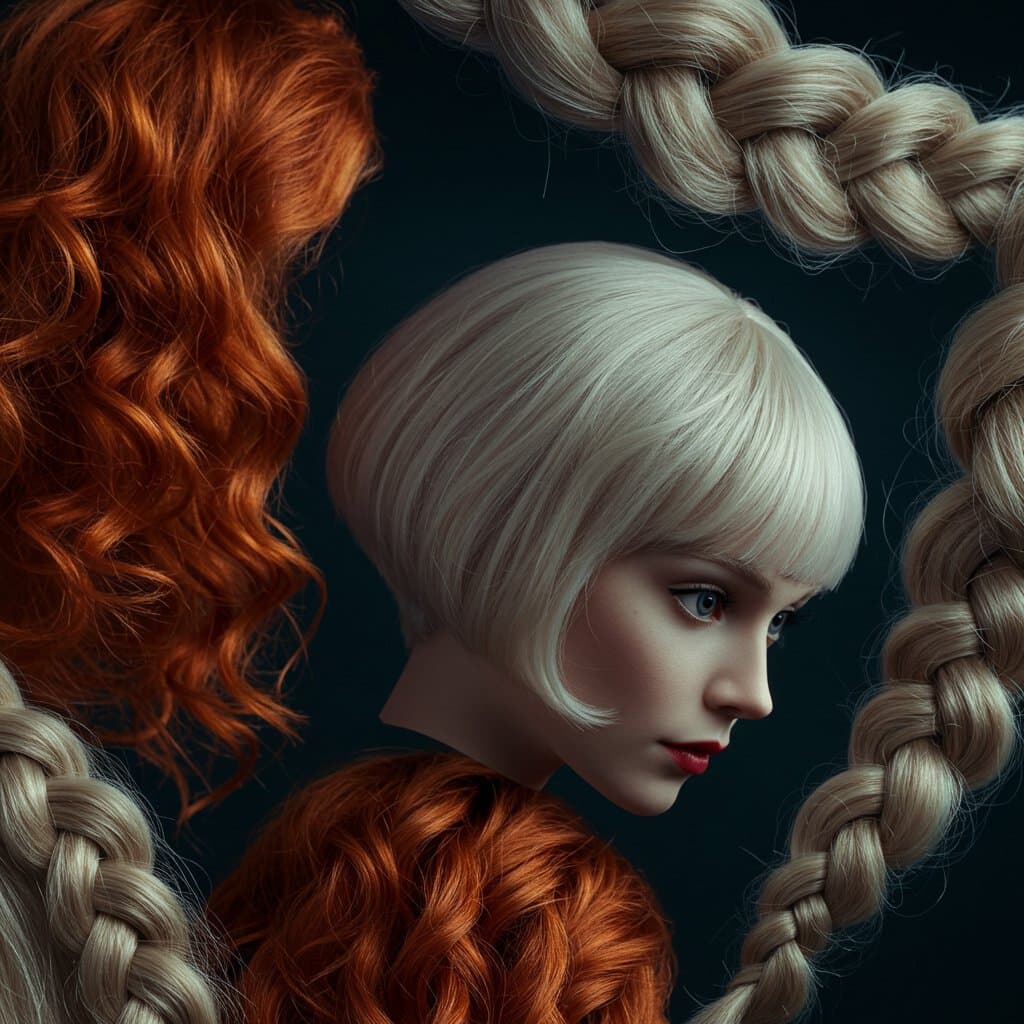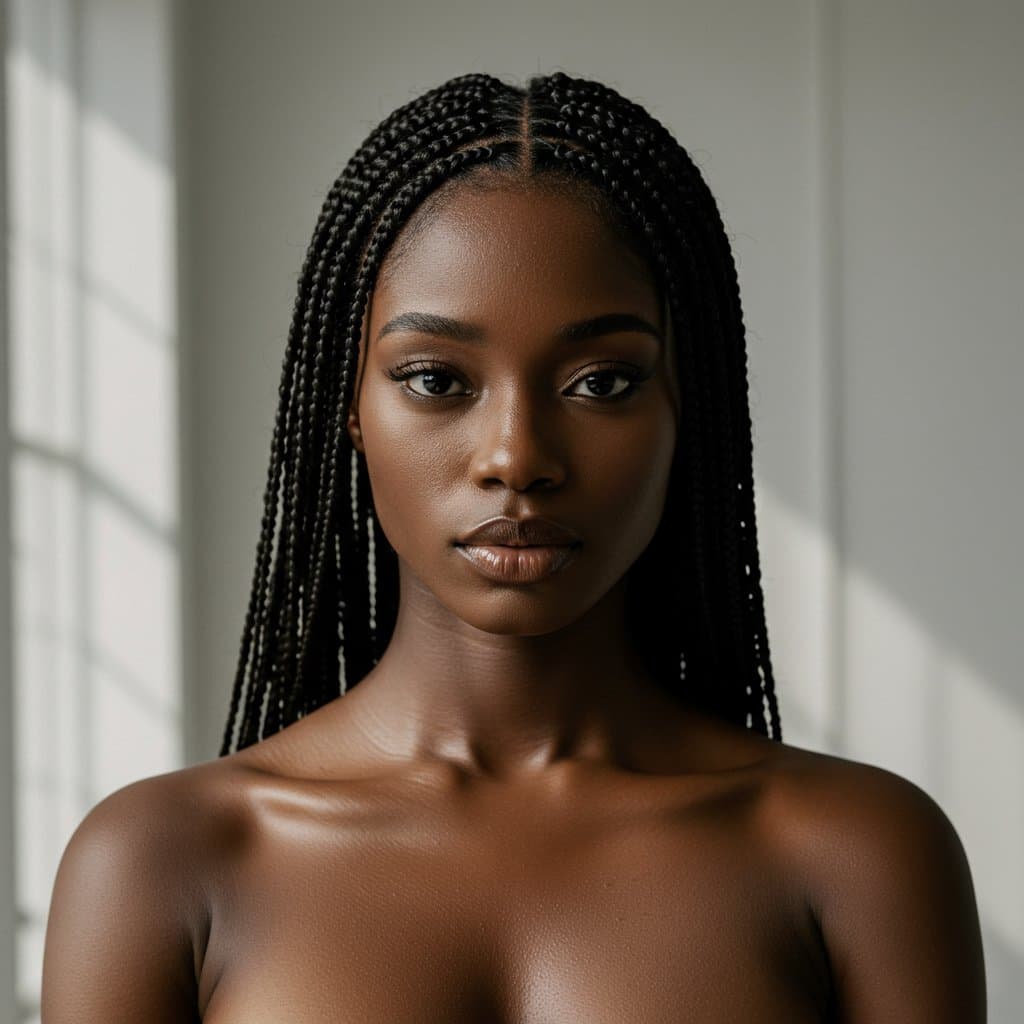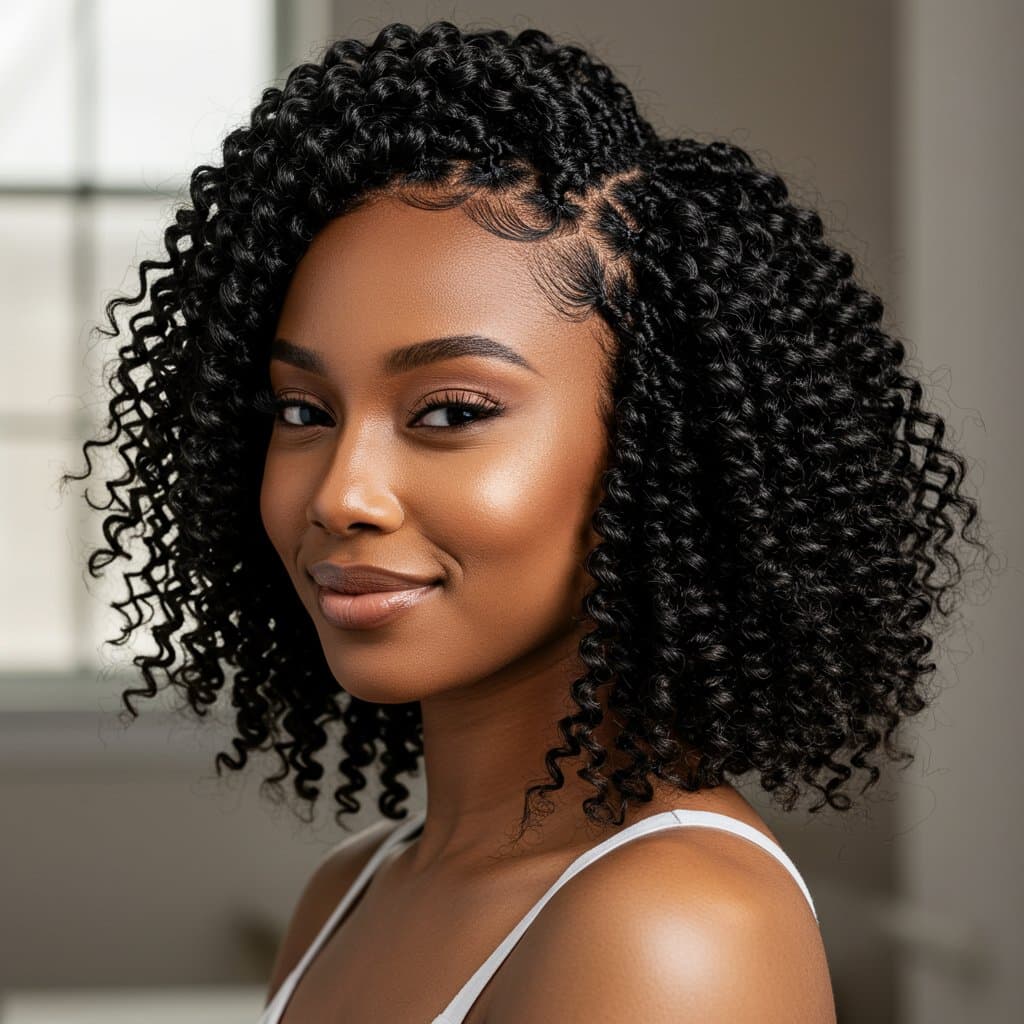
Predicting the Woman Hairstyles of the Future: 7 Trends Shaping the Next Decade | Tech & Sustainability
12 min read

12 min read

12 min read

14 min read
Download our app to instantly see how you'd look with any hairstyle or color
Get the App
14 min read

12 min read

15 min gallery
Download our app to instantly see how you'd look with any hairstyle or color
Get the AppHair, in many cultures, is more than just a physical attribute; it is a powerful symbol of identity, status, and artistry. Nowhere is this more evident than in the history of traditional Japanese hairstyles. From the flowing, floor-length locks of Heian court ladies to the formidable topknots of the samurai, hair in Japan has long been a canvas for expressing social standing, marital status, profession, and profound aesthetic principles. These intricate coiffures were not merely fashion statements but complex structures steeped in centuries of tradition and symbolism, telling a story about the person who wore them.

This guide delves into the captivating world of traditional Japanese hairstyles, exploring the evolution of these stunning creations through different historical eras. We will journey from the aristocratic courts to the battlefields, uncovering the secrets behind the geisha's elaborate updos and the samurai's practical yet symbolic `chonmage`. Understanding these historical styles offers a deeper appreciation for the meticulous craftsmanship and cultural significance woven into every strand, a legacy that continues to inspire hair artists and beauty enthusiasts around the globe. Prepare to explore a rich heritage where hair becomes a masterpiece of cultural expression.
---
The Heian period is often regarded as a golden age of Japanese imperial court culture, a time of unparalleled refinement in poetry, literature, and aesthetics. This dedication to beauty was perfectly mirrored in the era's prevailing hairstyle for aristocratic women: the `taregami` (垂髪), or "hanging-down hair." The ideal was incredibly long, straight, jet-black hair that flowed down the back, often reaching the floor. This style, known as `suberakashi`, was the ultimate symbol of feminine beauty, nobility, and high social status. The longer and more lustrous a woman's hair, the more beautiful she was considered.

Maintaining such extraordinary length required immense care and dedication. Court ladies would comb their hair daily with special boxwood combs (`tsuge-gushi`) and treat it with oils to maintain its health and shine. The `taregami` style was deceptively simple in appearance but profound in its cultural significance. It represented a life of leisure, as such a hairstyle would have been impractical for anyone engaged in manual labor. Seen in famous works like The Tale of Genji, this hairstyle captures the serene, elegant, and insulated world of the Heian aristocracy, setting a standard for beauty that would influence Japanese aesthetics for centuries to come.
While the style appears unadorned, subtle variations existed. For ceremonial occasions, parts of the hair might be tied back at the sides in a style called `bin-zura`. The sheer visual impact of a woman with a cascade of perfect black hair trailing behind her as she moved through the palace corridors was a powerful statement of her place in the world. It was a living embodiment of the period's obsession with understated elegance and natural beauty, a stark contrast to the more structured and complex styles that would emerge in later eras.
---
Following centuries of civil war, the Edo period ushered in an era of peace, stability, and economic growth under the Tokugawa shogunate. This newfound prosperity led to a cultural blossoming, particularly among the rising merchant class. As cities like Edo (modern-day Tokyo) grew, so did a vibrant urban culture centered around arts and entertainment, including kabuki theater and the pleasure quarters. This dynamic environment became a fertile ground for the evolution of traditional Japanese hairstyles, leading to an incredible proliferation of complex and varied styles known collectively as `nihongami` (日本髪), or "Japanese hair."

Unlike the simple `taregami` of the Heian period, `nihongami` styles were elaborate, sculpted updos held in place with a special wax called `bintsuke-abura`. These coiffures were divided into distinct sections—the bangs (`maegami`), side locks (`bin`), the ponytail or bun at the back (`tabo` or `tsuto`), and the main topknot (`mage`). The shape and volume of each section could be manipulated to create countless variations, each with its own name and meaning. A woman's hairstyle could instantly communicate her age, social class, marital status, and even her profession. For example, the `marumage` was a rounded bun worn exclusively by married women, signifying their status with elegant subtlety.
This era also saw the rise of specialized artisans, the `kamiyui`, or professional hairdressers, who possessed the skill to create these architectural wonders. The styles were often adorned with a stunning array of hair ornaments, including `kushi` (combs) and `kanzashi` (hairpins), which became intricate works of art in their own right. The Edo period transformed Japanese hairstyling from a simple expression of status into a sophisticated and highly codified art form, reflecting the complex social fabric of a society at the peak of its traditional culture.
---
The hairstyles of geishas (or `geiko` in Kyoto dialect) and their apprentices (`maiko`) represent the apex of `nihongami` artistry. These are not just hairstyles; they are intricate sculptures that convey a wealth of information about the wearer's rank, training stage, and participation in specific events. A `maiko`'s hair is her own, painstakingly styled by a `kamiyui` once a week. To preserve the coiffure, she sleeps on a special wooden pillow called a `takamakura`. Her hairstyles change as she progresses through her training, acting as a visual resume of her career.

One of the most recognizable `maiko` styles is the `wareshinobu`, worn during her first years of training. It features a bun split in the middle, with a red silk ribbon (`kanoko`) visible inside, symbolizing her youth and innocence. As she becomes a senior `maiko`, she adopts the `ofuku` style, which is more subdued and no longer shows the red ribbon. The transition between these styles is a significant rite of passage. The hairstyles are always decorated with `hana-kanzashi`, long floral hairpins that change monthly to reflect the season, from plum blossoms in February to maple leaves in November.
Once a `maiko` becomes a full-fledged `geiko`, she typically begins wearing wigs, which are less demanding on her natural hair. The most common style for a `geiko` is the `geiko shimada` or `katsuyama`, elegant and sophisticated styles that signify her maturity and professional status. The `taka shimada`, a high chignon, is another famous style often associated with geishas but also traditionally worn by brides on their wedding day. It exudes a sense of grace and formality. The world of geisha hairstyles is a complex and beautiful language, where every curve, ornament, and detail is laden with meaning and tradition.
---
In stark contrast to the elaborate beauty of female hairstyles, the signature look of the samurai warrior was the `chonmage` (丁髷), a practical and symbolic topknot. The most distinctive feature of the classic `chonmage` was the shaved pate, known as the `sakayaki`. This practice originated for purely functional reasons on the battlefield. By shaving the top of the head, samurai could wear their heavy helmets (`kabuto`) more comfortably, reducing heat and irritation during long campaigns and intense combat. The remaining hair on the sides and back was oiled, gathered, and tied into a queue that was then folded forward over the bare scalp.

Over time, as Japan entered the peaceful Edo period and the samurai transitioned from warriors to a ruling administrative class, the `chonmage` evolved. It shed its purely practical purpose and became a powerful symbol of samurai status and allegiance to a feudal lord. The act of wearing the `chonmage` was a declaration of one's position in the rigid social hierarchy. Different styles of folding the topknot could indicate rank and affiliation. The meticulous grooming of the `sakayaki` and the neatness of the topknot became a matter of personal honor and discipline.
With the Meiji Restoration in 1868, the samurai class was abolished, and the government issued the Dampatsurei Edict, which encouraged men to cut their `chonmage` in favor of Western hairstyles (`zangiri`). This was a deeply symbolic act, representing Japan's rapid modernization and departure from its feudal past. For many former samurai, cutting the topknot was a difficult and emotional moment, severing a direct link to their identity and heritage. Today, the `chonmage` is seen almost exclusively on sumo wrestlers, who continue this tradition as a link to their sport's ancient roots and samurai culture.
---
While the elaborate styles of the geisha and the iconic topknots of the samurai often dominate discussions of traditional Japanese hairstyles, the daily coiffures of the common people during the Edo period were equally diverse and meaningful. For merchants, artisans, and farmers, hairstyles had to be more practical yet still adhered to social conventions that communicated identity and status. These styles, while less ornate than those of the upper classes, possessed their own distinct charm and complexity.

For women, the most widespread style was the `shimada mage`, which had numerous variations. The `marumage` (丸髷), or "round chignon," was the quintessential hairstyle for married women. Its rounded, neat shape signified domesticity and maturity. Unmarried young women, on the other hand, often wore a variation of the `shimada` with a boxier shape at the back of the neck, known as the `momoware` ("split peach"), which, like the maiko's `wareshinobu`, had a red ribbon peeking through. These visual cues were an essential part of social communication in a highly structured society.
Men of the merchant and artisan classes also wore a form of topknot, but it differed from the samurai's `chonmage`. They typically did not shave their pate, instead sweeping all their hair up into a neat bun or a style called the `ichō-mage` (ginkgo-leaf knot), which was popular among craftsmen and traders. These styles were functional, keeping hair out of the way during work, while still presenting a respectable and tidy appearance. The hairstyles of the common people demonstrate the pervasiveness of `nihongami` culture, showing how every level of society participated in this rich form of visual expression.
---
Creating and maintaining the architectural marvels of `nihongami` required a specialized toolkit of finely crafted instruments and materials. These tools were not merely functional; they were often beautiful objects in their own right, treasured by their owners and passed down through generations. The artistry of the hairstyle was matched by the artistry of the tools used to create it.

At the heart of `nihongami` styling was `bintsuke-abura`, a hard wax made from Japan wax tree sumac and rapeseed oil. This wax was softened over a flame, applied to the hair, and then used to sculpt and hold the intricate shapes of the coiffure. Its firm hold was essential for ensuring the hairstyle would last for several days. To work with the hair, stylists used `tsuge-gushi`, combs hand-carved from boxwood. This wood is incredibly dense and static-free, making it perfect for smoothing and styling hair without causing damage. Different combs had different teeth spacing for various tasks, from detangling to fine-tuning the final shape.
The final touch, and perhaps the most dazzling element, was the addition of hair ornaments. `Kanzashi` (簪) are decorative hairpins that come in an astonishing variety of forms. They could be simple wooden sticks, elaborate floral arrangements (`hana-kanzashi`), dangling metallic ornaments (`bira-bira`), or jade-like balls (`tama-kanzashi`). The material, style, and motif of a `kanzashi` could signify wealth, season, or occasion. Along with `kanzashi`, decorative combs (`kushi`) and other pins (`kogai`) were inserted into the finished style, completing the masterpiece.
---
The era of wearing `nihongami` as a daily custom may be over, but the legacy of traditional Japanese hairstyles continues to thrive in modern culture. These classic forms have not been forgotten; instead, they have been preserved and adapted, finding new life in ceremonial contexts, artistic expressions, and contemporary fashion. They serve as a powerful link to Japan's rich cultural past and continue to inspire new generations of stylists and designers.

One of the most visible places traditional hairstyles are seen today is in Japanese weddings. Many brides choose to wear a traditional `shiromuku` (white kimono) for the Shinto ceremony, often paired with an elaborate wig styled in the `taka shimada` or `bunkin takashimada`. This elegant, high chignon is a timeless symbol of formality and bridal beauty. Similarly, traditional hairstyles are a key component of festivals (`matsuri`), coming-of-age ceremonies (`Seijin no Hi`), and performances of classical arts like kabuki and `nihon-buyo` (traditional dance).
Beyond these formal occasions, the aesthetic principles of `nihongami`—asymmetry, sculpted shapes, and the interplay of sleekness and volume—frequently influence modern hairstyling. Professional hair salons often create sophisticated updos for special events that draw inspiration from traditional forms, incorporating elegant twists, deep side parts, and the strategic placement of minimalist, `kanzashi`-inspired hair accessories. These modern interpretations prove that the spirit of traditional Japanese hairstyling is not a relic of the past but a living art form that continues to evolve and enchant.
---
While recreating a historically accurate `nihongami` style requires specialized training, you can easily incorporate the elegance and principles of traditional Japanese hairstyling into a contemporary look. Consulting with an experienced stylist can help you translate these timeless aesthetics into a wearable, modern masterpiece. Here are a few tips:

---
---
Traditional Japanese hairstyles are far more than just historical fashions; they are a profound reflection of Japan's culture, social structure, and aesthetic values. From the elegant simplicity of the Heian court's `taregami` to the complex, message-laden `nihongami` of the Edo period and the formidable `chonmage` of the samurai, each style tells a rich story of its time. They represent a remarkable fusion of artistry, symbolism, and meticulous craftsmanship.
The dedication required to create and maintain these coiffures speaks to a deep cultural respect for hair as a medium of expression. Today, this legacy continues to inspire, influencing everything from bridal fashion to avant-garde runway looks. By understanding the history and meaning behind these styles, we gain a deeper appreciation for the artistry of hairstyling and its power to communicate identity, heritage, and timeless beauty across the ages.
Download our app to instantly see how you'd look with any hairstyle or color
Get the App
12 min read

12 min read

14 min read